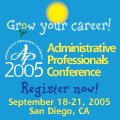 Many
people approach training as an adult much like they approached classes
when they were in school – and those strategies aren’t always
the best ones to maximize the value from a learning experience. Regardless
of the length, situation or topic, there are some very specific things
that you can do to convert the experience into useful learning you can
apply in your work and life. Many
people approach training as an adult much like they approached classes
when they were in school – and those strategies aren’t always
the best ones to maximize the value from a learning experience. Regardless
of the length, situation or topic, there are some very specific things
that you can do to convert the experience into useful learning you can
apply in your work and life.
Following are seven strategies that you can apply to convert your time
and energy spent in training into real useful learning.
1. Have a goal. Been signed up for some training at work? Decided
to attend a seminar on a topic you are interested in? Great! The first
thing you should do in any case is set a learning goal. If you are already
knowledgeable about the topic and have specific things you want to improve,
setting your goal or goals should be easy. If this is training you are
less excited about attending, or are unclear about, you can still set
a goal like: “Learn one new thing I can apply at work,” or “Meet
one person I can add to my network.” Having a goal and writing
it down focuses your mind and will help you gain real practical value
from any learning situation.
2. Take personal responsibility. Take responsibility for your
own learning experience. The training may not be the most dynamic or
engaging you’ve ever been to, but that is ok, because you have
a goal. Make that your focus. Perhaps the trainer isn’t going to
cover that topic exactly. That’s ok – use their expertise.
Ask them at a break, probe for other resources. Stay focused on your
goal. Your learning is in your control. Take responsibility for getting
from the experience what you want and need.
3. Ask questions. Don’t understand something? Ask for clarification.
Want a little more information? Ask for it. A big part of being responsible
for your on learning is asking question to get what you need.
4. Ask the Golden Question. The most important question is the
one you won’t likely ask out loud. “How can I use what I
am learning?” This is the golden question because it helps us translate
the learning to real life. Ask this question of yourself through the
training experience. I keep a separate place to keep notes on the application
ideas I get from asking myself this question when I am in training. This
truly is the golden question. Ask it of yourself when you start to get
distracted, ask it of yourself at breaks. Soon it will become a natural
response and an amazingly valuable habit.
5. Learn from everyone. There are more people to learn from than
just the speaker/trainer. The other people in the room can be a great
way to learn. Tap into their experience and knowledge. Talk to the people
at your table or around you. Think of them as peer coaches. These people
can help you learn during the session and might become great people in
your network after you leave. Be involved, participate and allow yourself
to learn from everyone, not just the person in the front of the room.
6. Build an action plan. At the end of the training, build an
action plan. Review your goal(s) and build a plan to implement what you
have learned. Reflect on your answers to the golden question and resolve
that you will apply those ideas too. If the training has been really
valuable, you may have several ideas. This is great, but be realistic
on how much you can apply at a time. Build your plan recognizing that
you ay be able to implement some things tomorrow, but that other things
might need to be spread out over the next week or more.
7. Teach someone else. If you want to really lock in what you
have learned, share what you have learned with someone else. Talk to
a colleague back in the office. Share the concepts with a friend. Not
only have you helped the other person, but you have increased your mastery
and clarity of the ideas in your own mind.
Bonus tip # 8 – Review your notes. If you want to really retain
what you have learned for the long term, set up a process to review your
notes. Review them the evening after the event. Review them the next
day, and the next day. Then put a note in your to-do list to review them
one week later and one month later. Each review only needs to be five
minutes long. You are simply trying to build the concepts in your mind
through repetition and giving your mind a chance to spark new connections
and new ideas.
As you can see, these strategies don’t require any additional
monetary investment, just an investment of your focus and approach. Applying
just one of these strategies can have a major impact on your results.
Applying them collectively will put you among the learning elite.
Put these strategies some where so that you can review them before you
attend any training event. Over time the reminders will turn these strategies
into your own habits – habits that will help you move towards your
goals and potential.
About the Author
All Rights Reserved, Kevin Eikenberry. Kevin is Chief Potential Officer
of The Kevin Eikenberry Group (http://KevinEikenberry.com),
a learning consulting company that helps Clients reach their potential
through a variety of training, consulting and speaking services. To receive
your free special report on “Unleashing Your Potential” go
to http://www.kevineikenberry.com/uypw/index.asp or
call us at (317) 387-1424 or 888.LEARNER. |


